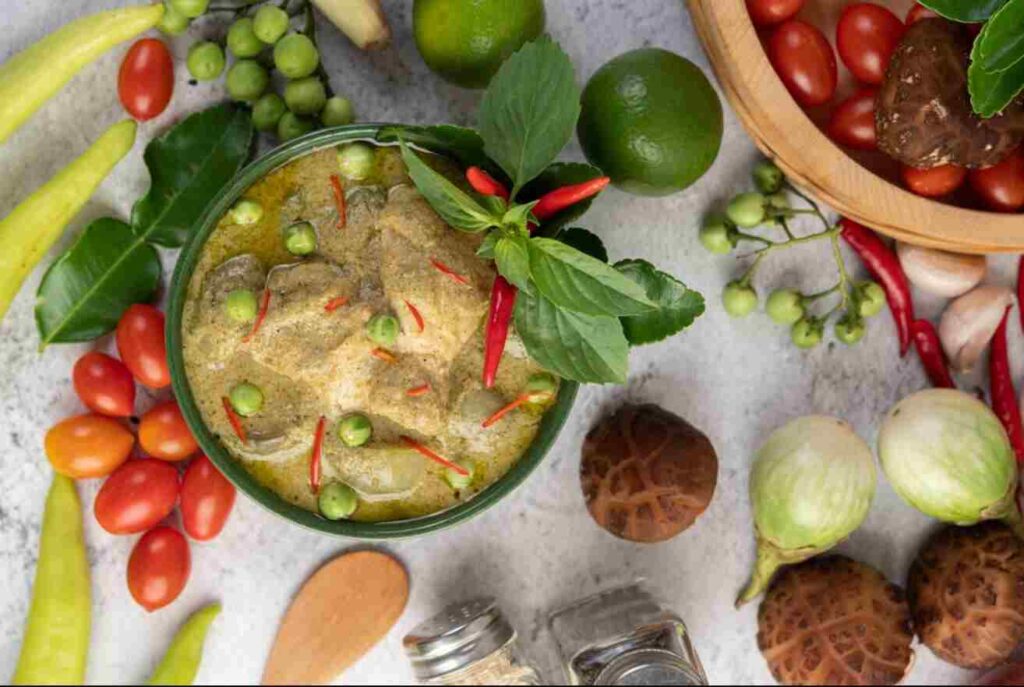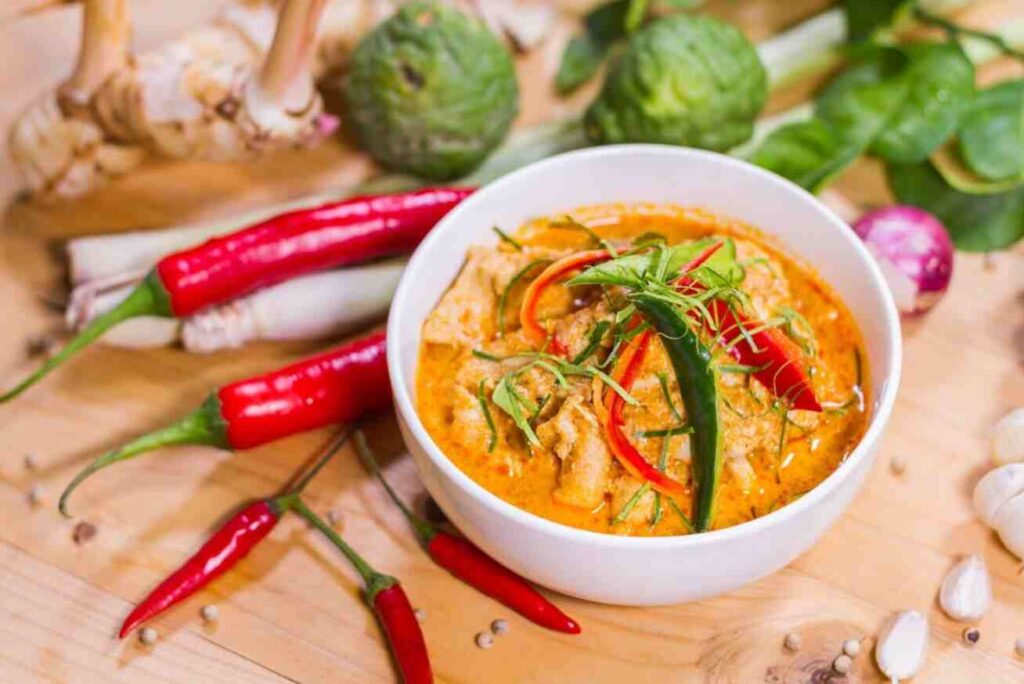Thai green curry is a beloved dish known for its rich flavors, creamy texture, and fragrant herbs. It is a staple in Thai cuisine, often enjoyed with rice or noodles. But is Thai green curry healthy? With its blend of coconut milk, green chilies, lemongrass, and fresh herbs, it offers a mix of essential nutrients and antioxidants. However, its healthiness depends on the ingredients and preparation methods used.
As one of the most popular Thai curries, green curry is praised for its bold flavors and versatility. Traditionally made with coconut milk, protein (chicken, tofu, or shrimp), and vegetables, it provides a satisfying and nutrient-dense meal. While it offers health benefits such as anti-inflammatory properties and a good source of vitamins, it can also be high in calories and saturated fats.
So, is Thai green curry a healthy choice? The answer depends on portion size, ingredients, and preparation methods. In this article, we’ll explore the nutritional profile, health benefits, and ways to make Thai green curry a more balanced and nutritious meal.
Nutritional Breakdown of Thai Green Curry
The nutritional content of Thai green curry can vary depending on the ingredients and portion size. Below is an approximate breakdown for one serving (1 cup or 240g) of Thai green curry made with chicken, coconut milk, and vegetables.

| Nutrient | Approximate Value (Per Serving) |
|---|---|
| Calories | 350-450 kcal |
| Carbohydrates | 15-25g |
| Protein | 20-25g |
| Fats | 25-35g |
| Saturated Fat | 15-20g |
| Fiber | 3-5g |
| Sodium | 700-1000mg (varies based on fish sauce & paste) |
| Key Vitamins & Minerals | |
| Vitamin C | Supports immunity (from green chilies, lime, and basil) |
| Iron | Essential for blood health (from protein sources & coconut milk) |
| Potassium | Helps regulate blood pressure (from coconut milk, vegetables) |
| Magnesium | Supports muscle and nerve function (from coconut milk, herbs) |
Key Takeaways
- Rich in healthy fats from coconut milk but can be high in saturated fat.
- Good source of protein when made with lean meats like chicken or plant-based options like tofu.
- Contains essential vitamins and minerals from herbs and spices, supporting overall health.
- Moderate to high in calories, especially when paired with rice.
To make Thai green curry healthier, consider using light coconut milk, increasing vegetables, and reducing sodium from store-bought curry pastes.
Health Benefits of Thai Green Curry
Thai green curry is not just a flavorful dish—it also offers several health benefits thanks to its nutrient-rich ingredients. Here are five key health benefits of Thai green curry:
Rich in Antioxidants
Thai green curry contains a variety of antioxidant-rich ingredients, including green chilies, basil, kaffir lime leaves, and coriander. These antioxidants help combat oxidative stress, reduce inflammation, and support overall immune function. Capsaicin from green chilies may also boost metabolism and aid in weight management.
Good Source of Protein
When prepared with chicken, tofu, shrimp, or other lean proteins, Thai green curry provides a solid source of protein, essential for muscle growth, repair, and overall health. Protein also helps keep you full longer, reducing the likelihood of overeating.
Supports Digestion
Ingredients like lemongrass, galangal, and coconut milk aid digestion and promote gut health. Lemongrass has antimicrobial properties that support a healthy gut microbiome, while coconut milk contains medium-chain triglycerides (MCTs), which are easier to digest than other fats.
Contains Heart-Healthy Fats
Although coconut milk is high in saturated fat, it contains MCTs, which may help raise good cholesterol (HDL) and provide a quick energy source. When consumed in moderation, the healthy fats in Thai green curry can support heart and brain function.
Provides Essential Vitamins and Minerals
Thai green curry is a natural source of vitamin C, iron, potassium, and magnesium. These nutrients contribute to a stronger immune system, better blood circulation, and muscle function. The fresh herbs and vegetables in the dish further enhance its nutritional value.
While Thai green curry has multiple health benefits, its calorie and fat content should be considered, especially when eating restaurant-prepared versions. Opting for light coconut milk, more vegetables, and lean protein can make it a more balanced and nutritious meal.
Is Thai Green Curry High in Calories?
Thai green curry is known for its creamy texture and rich flavors, but is it high in calories? The calorie content largely depends on coconut milk, portion size, and additional ingredients like protein and rice.

How Coconut Milk Affects Calories and Fat Content
Coconut milk is a key ingredient in Thai green curry, providing its signature creamy texture. However, it is also high in calories and fat:
- Full-fat coconut milk: ~445 calories and 48g of fat per cup
- Light coconut milk: ~150 calories and 14g of fat per cup
The saturated fat in coconut milk can raise total calorie intake, but it also contains medium-chain triglycerides (MCTs), which may provide quick energy and support metabolism.
Homemade vs. Restaurant Versions
| Factor | Homemade Thai Green Curry | Restaurant Thai Green Curry |
|---|---|---|
| Calories per serving | 300-400 kcal | 500-800 kcal |
| Fat Content | 15-25g (adjustable) | 30-50g (often high in coconut milk & oil) |
| Sodium | 500-800mg (can be reduced) | 1000-1500mg (high due to fish sauce & pastes) |
| Sugar | Minimal (depends on added sugar) | Higher (often sweetened for taste balance) |
How to Make Thai Green Curry Healthier
Thai green curry can be a nutritious meal, but small adjustments can make it even healthier without sacrificing flavor. Here are some simple ways to lighten up your curry while maintaining its authentic taste:
Use Light Coconut Milk or Greek Yogurt as a Substitute
Traditional Thai green curry is made with full-fat coconut milk, which adds richness but also increases calories and saturated fat. To make a healthier version:
✔ Swap full-fat coconut milk for light coconut milk – this reduces fat and calories by more than half.
✔ Use Greek yogurt as a creamy, high-protein alternative while keeping the dish thick and flavorful.
✔ Try unsweetened almond or cashew milk for an even lower-calorie option.
Increase Vegetable Content
Adding more vegetables boosts fiber, vitamins, and minerals while lowering calorie density. Great vegetable options include:
✔ Bell peppers – rich in vitamin C and antioxidants.
✔ Zucchini – low in calories, high in water content.
✔ Spinach or kale – adds iron and fiber.
✔ Carrots, green beans, or broccoli – enhance texture and nutrition.
Reduce Sodium and Sugar
Many store-bought curry pastes and sauces contain high amounts of salt and added sugar, which can contribute to high blood pressure and excess calorie intake. To lower sodium and sugar:
✔ Use homemade curry paste with fresh ingredients instead of store-bought versions.
✔ Reduce fish sauce or use low-sodium soy sauce for salt control.
✔ Avoid adding extra sugar—the natural sweetness from coconut milk and vegetables is often enough.
Choose Lean Proteins
While traditional Thai green curry often includes fatty cuts of meat, swapping for lean protein sources can lower saturated fat and boost nutrition:
✔ Chicken breast – high in protein, low in fat.
✔ Shrimp – low in calories, rich in omega-3s.
✔ Tofu or tempeh – great plant-based protein with added fiber.
✔ Legumes (chickpeas, lentils) – increase protein and fiber for a filling, plant-based alternative.
By making small changes—swapping coconut milk, adding more vegetables, reducing sodium, and choosing lean proteins—you can enjoy a healthier version of Thai green curry without losing its delicious taste.
Thai Green Curry vs. Other Thai Curries – Which is Healthier?
Thai cuisine is known for its rich and aromatic curries, with green, red, and yellow curries being the most popular. While they share common ingredients, their nutrition, spice levels, and calorie content vary. Let’s compare them to see which is the healthiest option.
Nutritional Comparison: Green vs. Red vs. Yellow Curry
| Curry Type | Calories (Per Cup) | Fat (g) | Protein (g) | Carb (g) | Spice Level |
|---|---|---|---|---|---|
| Green Curry | 350-450 kcal | 25-35g | 20-25g | 15-25g | 🔥🔥🔥 (Very Spicy) |
| Red Curry | 400-500 kcal | 30-40g | 20-25g | 15-30g | 🔥🔥 (Moderately Spicy) |
| Yellow Curry | 450-550 kcal | 35-45g | 15-20g | 25-35g | 🔥 (Mild) |
Key Differences Between Thai Curries
Green Curry 🍃
- Spiciest of the three, thanks to green chilies and fresh herbs.
- Slightly lower in calories and fat than red and yellow curries.
- Often contains lemongrass, basil, and kaffir lime leaves, which add antioxidants.
Red Curry 🌶️
- Made with red chilies, giving it a rich, deep flavor.
- Slightly higher in calories and fat due to more coconut milk and oil.
- Still nutrient-dense but less spicy than green curry.
Yellow Curry 🍛
- The mildest, with a sweeter taste due to turmeric, cumin, and cinnamon.
- Typically higher in calories and fat due to more coconut milk and potatoes.
- Turmeric gives it anti-inflammatory benefits, but it’s often carb-heavy.
Which is the Healthiest?
✅ Best for Weight Management: Green Curry (fewer calories, leaner ingredients)
✅ Best for Anti-Inflammatory Benefits: Yellow Curry (turmeric-rich)
✅ Best for a Balanced Meal: Red Curry (moderate spice, well-rounded nutrition)
Thai green curry is generally the healthiest option due to its lower calorie content and high antioxidant levels. However, all three can be healthy if made with lean proteins, more vegetables, and lighter coconut milk.
FAQs
1. Is Thai green curry healthy?
Yes, Thai green curry is nutritious, but its healthiness depends on ingredients. Using lean protein, more vegetables, and light coconut milk makes it a healthier option.
2. Is Thai green curry high in calories?
It can be, mainly due to coconut milk. Restaurant versions are often 500+ calories, but homemade versions with light coconut milk can be around 300-400 calories.
3. Can I eat Thai green curry on a diet?
Yes! Opt for lean proteins, more vegetables, and light coconut milk to keep it low-calorie and nutritious. Pairing it with cauliflower rice can further reduce carbs.
4. Is Thai green curry keto-friendly?
Mostly, yes! It’s high in healthy fats and protein. To keep it keto, avoid sugar, limit onions, and pair with low-carb sides instead of rice.
5. How can I make Thai green curry healthier?
Use light coconut milk, increase vegetables, reduce sodium, and choose lean proteins like chicken breast, shrimp, or tofu for a more balanced meal.
Conclusion
Thai green curry is a flavorful and nutrient-rich dish that can be both healthy and indulgent, depending on how it’s prepared. While it provides antioxidants, protein, and essential vitamins, it can also be high in calories and saturated fats due to coconut milk and added oils.
Making small adjustments—such as using light coconut milk, increasing vegetables, reducing sodium, and choosing lean proteins—can transform Thai green curry into a balanced and wholesome meal. Homemade versions allow greater control over ingredients, making them a healthier choice compared to restaurant servings.
Ultimately, Thai green curry can be a healthy addition to your diet when consumed in moderation and with mindful ingredient choices. Whether you’re looking for a nutritious meal or a comforting dish, making simple swaps ensures you enjoy its delicious flavors while maintaining a healthy lifestyle.


